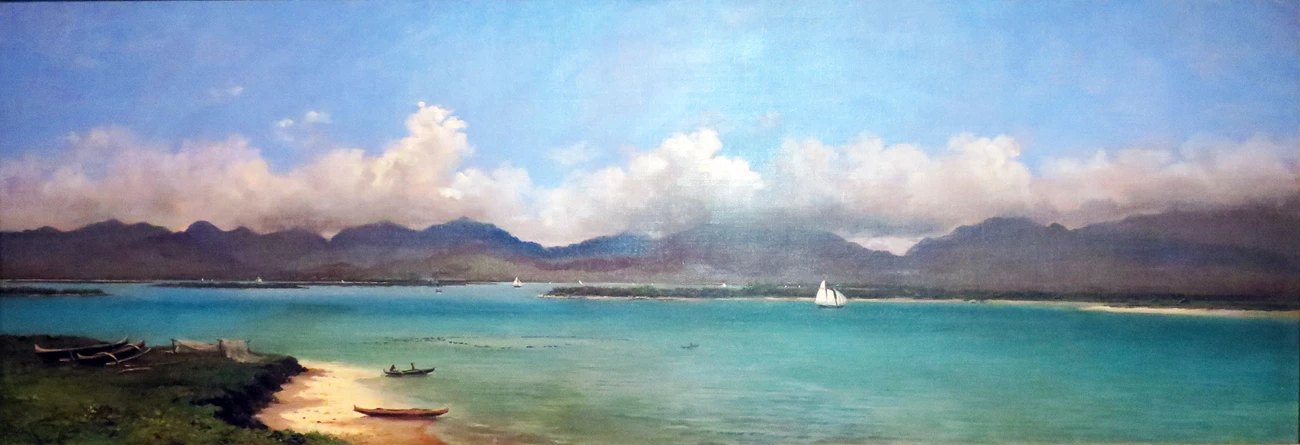
Pearl Harbor: Echoes of a Storied PastJust as the luster of a pearl shifts with the light of day, so too has Pearl Harbor transformed in the light of history. This remarkable port, home to the U.S. Pacific Fleet, has long been recognized for its scenic beauty, strategic importance, and historical significance—long before the events of December 7, 1941, forever changed its legacy. Known as one of the greatest harbors in the Pacific, Pearl Harbor has been a coveted location throughout history, with nations vying for control of its blue-green waters. Wai Momi: The Ancient Hawaiian PearlIn ancient times, the Hawaiians referred to this area as Wai Momi, or "Waters of Pearl," for the abundance of pearl-producing oysters that thrived in the bay. The harbor's pristine waters and rich fishponds made it a vital source of sustenance for the Hawaiian people. According to legend, the shark goddess Kaʻahupahau watched over the waters, protecting the bay's natural resources. Just as the ancient Hawaiians valued Wai Momi, the United States today honors Pearl Harbor as a site of both cultural and military significance. A Harbor Transformed: The Rise of Pearl Harbor as a Strategic PortWhen Captain James Cook first arrived in Hawaii in 1778, Wai Momi was largely inaccessible due to a coral reef that blocked entry for deep-draft ships. For decades, Honolulu Harbor remained the preferred destination for Western ships. However, in 1826, the U.S. Navy first made contact with the islands when the USS Dolphin sailed into port, sparking an interest in Pearl Harbor’s potential. It wasn't until 1840 that a naval officer recognized the deep inner harbor could be accessed by removing the obstructing reef. Despite gaining exclusive rights to Pearl Harbor in 1887, it took the U.S. until after the Spanish-American War to fully recognize the strategic importance of the harbor. In 1902, the U.S. began dredging and deepening the harbor, creating a 600-foot-wide, 35-foot-deep channel to allow large naval vessels access. This monumental effort established Pearl Harbor as a vital military port, capable of supporting the U.S. fleet. Official Naval Base and the Pacific FleetIn 1908, Congress officially designated Pearl Harbor as a U.S. naval base, and in 1911, the USS California became the first large ship to enter the harbor. As Japan rose to power in the early 20th century, the U.S. shifted its naval focus to the Pacific, making Pearl Harbor the home of the Pacific Fleet. Ironically, the same actions taken to protect the U.S. from threats in the Pacific would later make it a prime target. The Attack on Pearl Harbor and the USS Arizona MemorialOn December 7, 1941, the tranquility of Pearl Harbor was shattered when Japan launched a surprise attack, drawing the U.S. into World War II. The USS Arizona and many other ships were destroyed, and thousands of lives were lost. In 1962, the USS Arizona Memorial was dedicated to honor the men who died defending Pearl Harbor during the attack. In 1989, the USS Arizona was designated a national historic landmark. Since 1980, the National Park Service has operated the memorial and its visitor center, ensuring the preservation and interpretation of the historical significance of the site. Veterans and organizations like Pacific Historic Parks, working alongside Pearl Harbor survivors, continue to support the memorial and ensure its legacy endures. Pearl Harbor Today: A Place of Reflection and LearningToday, Pearl Harbor serves not only as a reminder of the devastating attack but also as a symbol of resilience, reflection, and remembrance. The USS Arizona Memorial welcomes more than 1.4 million visitors annually, offering a space for people from around the world to honor those who lost their lives. To accommodate this diverse audience, brochures are available in over 30 languages, and audio programs are offered in seven languages, ensuring that the stories of courage and sacrifice are accessible to all. For the native Hawaiian people, Pearl Harbor, once known as Wai Momi, holds deep cultural and spiritual significance. Long before the events of December 7, 1941, the harbor provided sustenance and was revered for its natural abundance. It was a place where land, sea, and the Hawaiian people were deeply interconnected. As we honor the fallen and reflect on the pivotal role Pearl Harbor played in history, it is important to acknowledge and respect the sacred ties this land holds for the indigenous people of Hawaii. Pearl Harbor continues to embody both the sacrifices made during World War II and the enduring spirit of those who have long cherished its waters. Through remembrance and reflection, we ensure that Pearl Harbor’s history and cultural significance are preserved for future generations, uniting past and present in a shared commitment to never forget. |
Last updated: September 13, 2024
